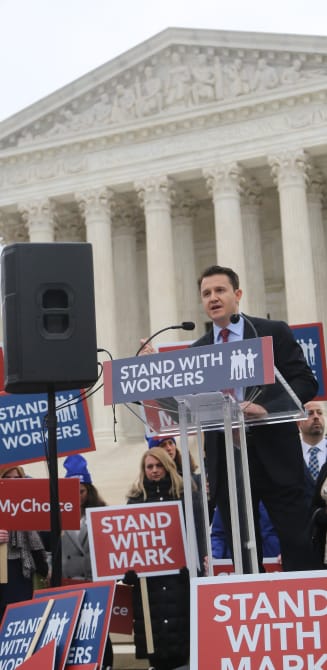Arizona school district superintendents receive high salaries. Yet, the true scale of that pay is often obscured by a tangle of complex contract provisions that school boards, and the superintendents themselves, deliberately design to mask the full measure of compensation from taxpayers. These same school districts go to great lengths to block access to superintendent contracts—in some cases, even from their own board members—shielding from the public how tax dollars enrich those who often are their community’s highest-paid public employees.
By combining as many as ten different ways to compensate a superintendent, school districts hide the true level of pay for these individuals. Most often, the only compensation for a superintendent that is publicly known is the initial base salary—which rarely tells the whole story.
To uncover the real cost of Arizona’s school superintendent salaries, the Goldwater Institute requested contracts from 41 of the largest school districts in the state. Four months later—after enduring school district stonewalling, sending repeated requests to those districts, and even raising the prospect of legal action against them — Goldwater finally forced every district into the open.
Goldwater undertook this project on behalf of taxpayers. The effort was designed to shed light on superintendent salaries and to measure the transparency of Arizona school districts when responding to a request for one of the most basic documents that should be available to the public—a school leader’s contract.
Executive Summary
The results of the study were eye-opening:
- While superintendent base salaries average approximately $215,000 a year, taxpayers are charged up to $490,000 per superintendent after accounting for other lucrative perks. And that’s before factoring in health insurance and pension costs under the Arizona State Retirement System. Including the latter benefit would push the total tax bill well over half a million dollars for a single district employee.
- Taxpayers pay up to $1,250 per month for some superintendents to receive monthly “car allowances,” a price large enough to lease a Corvette or purchase a brand-new vehicle roughly every 2-3 years.
- Dozens of districts are double charging taxpayers for superintendents’ retirement packages, funding private retirement accounts on top of their already generous state pension benefits. The Phoenix Union High School District, for example, spends over $45,000 per year on employer contributions to a personal retirement account for the superintendent, in addition to what taxpayers already spend for her public pension.
- Taxpayers are paying for generous personal and vacation leave banks for superintendents—totaling up to 80 days (15 weeks) off when combined with school holidays, for which they are also paid to be off. The personal and vacation days can also be turned into additional compensation if the superintendent does not use them.
- One superintendent — Jeremy Calles, of the Tolleson Union High School District — is making nearly half a million dollars per year. That’s over $100,000 more than any other superintendent in Arizona—despite that this district is only the 16th largest in the state, and that most of his district’sschools are receiving “B” grades from the state and academic proficiency rates below statewide and peer districts: 21 percent for Math and 26 percent for English Language Arts (ELA).[1]
- All but one of 41 surveyed districts failed to publicly disclose the provisions of their superintendent pay packages, with 10 districts receiving an “F” grade in public transparency based on their responses to our clear, simple public– records requests for superintendent contracts.
Overall, we found that total superintendent compensation (excluding health and pension benefits) ranged from a low of $189,904 (Flagstaff Unified) to a whopping $491,360 (Tolleson Union, the highest in the state by more than $100,000). Total compensation figures can differ greatly from the salaries published by school districts, which usually only are base salaries. For example, Flagstaff Unified highlights only the superintendent’s base salary, which is $161,262; and that for Tolleson Union is $361,584 (still the highest in the state—by $111,000).
Total annual compensation for superintendents includes compensation from the following categories:
-
- Superintendent base salary
- Board approved “performance” pay
- Retirement contributions to 403(b) and 457 plans; although these are usually paid by the employee, many school districts substantially fund their superintendents’ plans—in addition to contributing to their superintendents’ accounts within the state retirement system
- Stipends, including car allowances (which are as high as $1,250 per month), administrative stipends, relocation/moving allowances, professional memberships, and/or development stipends
- Personal leave and vacation in addition to school holidays, the unused portion of which may be “cashed out” either each year or upon departure from the district, a benefit most employees do not have
- Spousal and dependent health insurance paid for by the school district (whereas other employees are given the choice of buying this coverage themselves at the group rate)
- Life insurance paid for by the school district
You can view the Arizona K-12 Superintendent Contracts chart here.
Transparency Grades
Arizona law requires open and transparent government. To that end, Arizona has broad public-records laws favoring the disclosure of records made and kept by public bodies and their officers. Under Arizona’s public-records law, Arizona school districts are public bodies and, when presented with a valid public-records request, must promptly disclose those records (the courts have held this means “at once”).
However, we found a disturbing pattern of school districts stonewalling requests for superintendent contracts. Of the 41 districts surveyed, 40 did not publish their superintendent contract online, even omitting it from meeting materials that documented the board’s approval. Many of the others put up unnecessary and illegal barriers to access, demanding excessive charges for physical (non-electronic) copies, requiring forms not supported by legal requirements, failing to respond within a reasonable timeframe, and/or flatly denying our disclosure requests. Many did not even acknowledge the request within five business days as required by law.
Based on these findings, and utilizing the rubric below, we have assigned all of the surveyed school districts public transparency grades, which are on the accompanying table. We believe these grades indicate how responsive each school district is—not only to requests for its superintendent contract, but also to public records requests more broadly.
Public Transparency Grades were earned under the rubric as follows:
A: Contract was received electronically with no resistance within 10 business days of public–records request.
B: Contract was received electronically with no resistance between 11-25 business days of public– records request.
C: Contract was received with no resistance more than 25 business days after the public-records request.
D: Contract was received within 25 business days of the public-records request but was resisted by demands for forms not required by law, refusal to provide digital copies, and/or charges for physical copies.
F: Significant resistance and/or delay greater than 25 business days.
Arizona School Superintendent Contracts Generally
The superintendent in a school district is essentially the CEO responsible for the day-to-day functions of the school district and for carrying out school board policy. The superintendent plays a central role in educational outcomes, personnel and budgetary decisions and oversight, and community relations. The superintendent is the only person the school board directly hires, supervises, evaluates, and fires. Superintendents in Arizona generally have many years of experience in a K-12 setting, including at least three years of teaching in the classroom (if the superintendent is certified for that role by the State Board of Education).
Superintendents can have contracts for up to three years in duration and cannot negotiate a new contract until 15 months before the expiration of their current contract. The contracts are approved by the school board. Superintendent compensation tends to rise in relation to the school district’s student count. However, there are exceptions, which can be seen in the table.
If the school board decides to make a change in leadership, unless firing for cause, the school district may have to pay the balance of the superintendent’s contract. The termination provisions of the contract, including the per diem rate and other payout terms, will dictate just how much the school district will have to pay the superintendent to walk away.
Notes About Common Contract Provisions
Base Salaries
The base salary is the most publicly available component of a superintendent’s compensation. When the school board approves the superintendent contract, it is most often the only compensation component released or available to the public. The base salary also determines things like retirement contributions, social security deductions, and taxes. If there are any automatic escalator provisions—say, a built-in annual increase of 5 percent—it usually applies to the base salary and not to other components of compensation.
The average base superintendent salary of the 41 Arizona school districts we surveyed was $214,030.
As mentioned previously, the highest starting salary in the state— by over $111,000 —is paid to the Tolleson Union High School District superintendent, Jeremy Calles. He draws this high pay despite Tolleson Union being only the 16th largest school district in the state, with most of its schools receiving “B” grades from the state, and with student academic proficiency rates below statewide and peer districts.[2]
Performance Pay
State law requires that up to 20 percent of superintendents’ annual pay must be classified as performance pay. The law does not require that total compensation be increased to cover this performance pay. In fact, legislative history supports the view that the Legislature intended a portion of a superintendent’s base salaryto be determined based on performance—meaning that superintendents would be incentivized to earn that portion by meeting performance goals. However, in every contract we reviewed, performance pay was added to the base salary, resulting in increased potential compensation. Performance pay amounts are approved by the school board annually, typically following the evaluation of the superintendent, although that is not required.
Annual performance– pay amounts in the districts we surveyed ranged from a low of $5,000 a year (Tucson USD, Agua Fria UHSD) to a high of $72,316 for Tolleson Union.
Retirement Contributions
Arizona school superintendents are part of the Arizona State Retirement System (ASRS). ASRS requires each employee and employer to make annual contributions with a percentage of the employee’s income diverted to ASRS to actuarily fund the obligations of the defined benefit plan. ASRS, unlike many other state retirement systems, is by most accounts well-managed, well-funded, and returns a considerable benefit to participants. For a superintendent with over 30 years’ experience in the system and making an average salary—$225,000, according to our survey—over their last five years of their careers they could expect an annual benefit upon retirement at age 55 of $141,750 and $155,000 a year starting at age 60.
Because all school employees receive retirement benefits, these are not covered in the table breakdown of this report. However, it is worth noting just how substantial this benefit is. Whereas most Americans rely on savings, 401(k)s, or other retirement accounts that are defined contribution plans—not knowing how much those contributions will yield in future income—ASRS participants rest assured of what they will receive, also knowing that they will receive that benefit for as long as they live.
Given this system, one might expect that additional retirement benefits would not be included in superintendent compensation. However, in almost every contract we reviewed, superintendents also received employer contributions to a 403(b) or 457 retirement plan. These are like 401(k) plans, and teachers and other school district employees do not have these plans typically funded by the school district.
Most 401(k) plans allow employers to match a portion of an employee’s contributions. Typical employer “matches” are 2-4 percent, meaning the employer matches an employee’s own contributions to the plan, up to that percentage of the employee’s salary. However, for the superintendent contracts we surveyed, the school district employer contributions were much higher than that. One school district—Phoenix Union—funded its superintendent’s 403(b) with annual contributions of $45,000 – almost 20% of the superintendent’s base salary. (The average employer contribution for the school superintendents receiving this benefit in our survey was $19,752 or 9% of the average base salary.) The employee is still able to contribute to the plan as well up to the legally allowed limits, providing a substantial retirement benefit in addition to ASRS.
Stipends
In addition to the compensation discussed above, all 41 school districts surveyed provide stipends to their superintendents. Most often, these stipends take the form of a monthly “car allowance,” but many districts also offer stipends for general administrative use, memberships in professional or civic organizations, and relocation stipends for superintendents moving to the district.
Car allowances vary considerably among the surveyed districts, from a high of $1,250 per month (Amphitheater USD, Sahuarita USD) to $500 per month (Marana USD, Littleton ESD). Some districts combine car and administrative allowances in a single annual stipend: Tucson USD pays $20,000 per year (or $1,666 per month); Alhambra ESD pays $18,000 per year (or $1,500 per month); and Laveen ESD pays$19,475 per year (or $1,621 per month).
It is notable that many districts did not preclude their superintendents from using district provided vehicles or from receiving additional mileage reimbursements for work– related travel while still receiving their car allowance stipend.
Personal Leave and Vacation
Any Arizona parent can tell you that there are a lot of school days off during the school year. These typically include every major holiday (seven days), Fall Break (one week), Winter Break (two weeks), and Spring Break (one week). All contracts we surveyed stipulated that superintendents would be off during these periods along with the rest of the school district staff.
However, in addition to these more than five weeks off, the school districts we surveyed also provide their superintendents with both personal and vacation leave. These included a high of 54 combined personal-leave and vacation days (Sunnyside USD), with the average exceeding 40 days off.
These staggering leave banks are notable for two reasons. First, they provide many superintendents with up to 15 weeks of paid vacation. Second, and more importantly, they function to conceal compensation: most superintendents could not practically do their jobs if they took all the leave provided in their contract.
Most contracts stipulate that accumulated days off over a certain threshold will be paid out annually at the superintendent’s per diem rate—essentially the daily rate the superintendent makes based on his annual salary. For example, in one school district (Dysart USD), this arrangement could result in an additional annual compensation of $40,935. Other school districts allow a superintendent to accumulate days over the life of the contract or their term of employment, which then can be compensated upon their departure fromthe district. This is the case in Tolleson Union, where the superintendent can bank up to 120 personal days; if this amount were accumulated, the district in that case would owe the superintendent a check for $166,184 on his last day.
Spousal and Dependent Health Insurance
Employer-provided health insurance is another valued employee benefit for teachers and other school district employees. Typically, the school district covers the entirety of an employee’s health insurance premium and allows employees to purchase health insurance for members of their immediate families at a discounted group rate.
For many of the school superintendents we surveyed, this is different. They receive both spousal and dependent health insurance coverage paid fully by the school district. This is a considerable benefit, allowing superintendents to avoid dipping into their salary—as other school employees do—to cover insurance premiums for family members.
However, given that details about plan selection and family members covered are not publicly available, the costs of this considerable benefit are not included in our compensation analysis.
Life Insurance
Almost all of the 41 school districts surveyed provide life insurance benefits to their superintendents. Many such policies pay beneficiaries two or three times the superintendent’s salary if the superintendent dies.
As with spousal and dependent care health insurance coverage, the requisite data is not available, so life insurance premiums are not included in our compensation analysis. Nonetheless, this is a considerable financial benefit to superintendents—paid for by school districts. As an example, the annual premium on a $1,000,000 survivor benefit life insurance policy for a 55-year-old adult male with a life expectancy of 80 would be approximately $6,000-$8,500 per year. Again, such premiums are paid by school districts per the terms of their contracts.
Conclusions and Recommendations
Superintendents have important jobs. In each district, they are the one employee the school board hires, supervises, and may ultimately terminate. The superintendent is responsible for student achievement, implementing board policy, recommending staff hires, and overseeing school district finances. They understandably command the highest salary in the school district.
However, there should be greater transparency in just how much they are paid. Their contracts may be among the most important public documents held by school districts. Because of this, these contracts should be readily available to the public. One Arizona school district, Flagstaff USD, has taken seriously their obligation of public transparency by making available their superintendent’s contract on their website for anyone to see. Other districts should follow suit. In fact, three states—Illinois, Indiana and Texas—have state laws requiring their school districts to post the superintendent contract online. Superintendent contracts legally are public records in all 50 states.
In addition, school districts should publish total compensation analyses for their superintendents, listing the value of all the perks that are included in their contracts. It is likely that most school board members do not fully understand how their superintendent is paid, nor all the sources of compensation the superintendent receives. Surprisingly, many have never even seen the superintendent’s contract, and some have been denied access when they’ve requested it.
Too often, school board members are rushed to enter these contracts without getting impartial advice or good, in-depth comparative data so they can evaluate whether they are providing competitive compensation to their new superintendent. Perhaps school boards should consider using outside legal counsel for contract negotiations with prospective superintendents. After all, if they do use the same legal counsel that they use for the district’s day-to-day legal work, that same counsel will eventually rely on the new superintendent for their livelihood. It is a built-in conflict of interest.
Finally, it’s worth considering whether school boards should adopt a simpler, more transparent approach by dispensing with all the excessive, distinct compensation provisions in a now-typical superintendent contract in favor of one comprehensive base salary with employee benefits provided being the same as the rest of the staff that they supervise. That would provide the greatest transparency, signal to teachers and other employees that the superintendent is treated on equal footing and send a clear message that nothing is being hidden.
End Notes
[1] [2] In the latest Arizona Department of Education School District Report Card, 26 percent of students were proficient in English Language Arts (ELA) and 21 percent of students were proficient in Math; these numbers were below both the statewide and peer-group (which considers socioeconomic status of students) averages.









